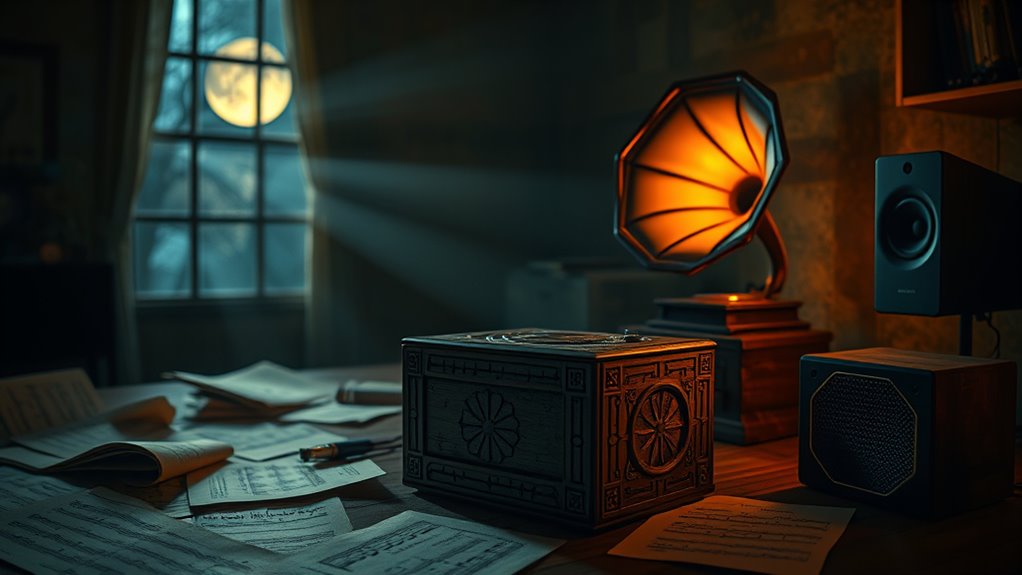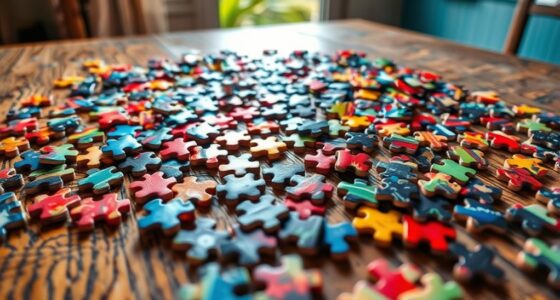Sound and music play a crucial role in puzzle experiences by immersing you in the environment, guiding your focus with subtle cues, and evoking emotions that make solving more engaging. Ambient sounds set the scene, while musical motifs reinforce themes and signal progress or errors. Strategic sound design influences your mood and decisions, creating a cohesive and memorable journey. Keep exploring to discover how these elements can transform your puzzle adventures into immersive worlds.
Key Takeaways
- Sound and music create immersive environments, making puzzles feel part of a larger, believable world.
- Auditory cues enhance focus, signal important clues, and guide players toward solutions.
- Musical motifs reinforce themes, evoke emotions, and help players recognize patterns or progress.
- Strategic sound design influences mood, decision-making, and engagement during puzzle solving.
- Integrating sound and music makes puzzles more intuitive, emotionally resonant, and memorable.

Have you ever noticed how sound and music can transform a simple puzzle into an immersive experience? When you’re solving a puzzle, the right auditory cues can heighten your focus, evoke emotions, and deepen your engagement. Ambient noise, subtle background sounds like rustling leaves or distant echoes, helps set the scene, making the puzzle feel like part of a larger world rather than an isolated task. These sounds create a layer of realism, drawing you into the environment and encouraging you to stay immersed longer. They also serve as subconscious cues, alerting you to important changes or hints within the puzzle. For example, a faint humming noise might signal that you’re close to a solution or that something important is about to happen. Incorporating sound design into puzzles is a strategic way to enhance user experience and engagement. Musical motifs, on the other hand, act as recurring themes that reinforce the puzzle’s narrative or emotional tone. When you hear a particular melody or motif repeated at key moments, it helps you recognize patterns and connect clues more intuitively. These motifs can evoke feelings of curiosity, tension, or satisfaction, guiding your emotional response and motivating you to keep going. They also serve as auditory anchors, making it easier to remember specific parts of the puzzle or the steps you’ve already completed. For instance, a rising musical phrase might indicate progress, while a dissonant chord can signal a dead end or error. When used effectively, musical motifs become a mental map, helping you navigate complex puzzles without relying solely on visual cues. Sound design in puzzles isn’t just about adding atmosphere; it’s a strategic tool that influences your perception and decision-making. Ambient noise subtly influences your mood and concentration, helping you maintain focus amid distractions. Meanwhile, musical motifs provide structure and emotional cues that make the experience more memorable and engaging. As you progress through a puzzle, these auditory elements work together to create a cohesive narrative, making the journey more intuitive and emotionally resonant. You may find yourself more motivated to solve the puzzle because the sounds evoke a sense of purpose and anticipation. Overall, incorporating thoughtful ambient noise and musical motifs transforms the puzzle-solving process into a richer, more immersive adventure, engaging your senses and intellect simultaneously.
Frequently Asked Questions
How Do Sound Cues Influence Puzzle Difficulty?
Sound cues can markedly influence puzzle difficulty by providing auditory clues that guide your thinking. When you recognize sound symbolism, these cues help you interpret hints more quickly, reducing frustration. Conversely, poorly timed or ambiguous auditory cues may increase difficulty, causing confusion. Your brain processes auditory cues actively, so clear, deliberate sounds can make puzzles easier, while confusing cues can challenge your problem-solving skills.
Can Music Enhance Memory During Puzzle-Solving?
Yes, music can enhance your memory during puzzle-solving by engaging your auditory memory. When you use musical mnemonics, melodies help you remember clues or steps more effectively. Listening to familiar tunes or creating specific musical cues creates mental associations, making it easier to recall information. This active use of sound strengthens your memory, keeps you focused, and can even boost your problem-solving skills throughout the puzzle.
Are There Cultural Differences in Sound-Based Puzzle Design?
Cultural differences definitely influence sound-based puzzle design, as cultural interpretations shape how sounds are perceived and understood. Sound symbolism varies across societies, meaning a tone or melody might evoke different emotions or ideas elsewhere. For example, a high-pitched tone might signal danger in one culture but excitement in another. Recognizing these nuances allows designers to craft puzzles that resonate globally, leveraging cultural insights to enhance engagement and comprehension.
What Psychological Effects Do Puzzle Sounds Have on Players?
Puzzle sounds shape your emotional response by triggering specific feelings through auditory perception. When you hear a satisfying chime, it boosts your confidence and motivation, while a discordant noise may cause frustration. These sounds influence your focus and engagement, making the puzzle more immersive. By carefully designing auditory cues, you can enhance your overall experience, helping you stay attentive and emotionally connected to the challenge.
How Is Adaptive Sound Used in Interactive Puzzle Games?
Think of adaptive audio as a chameleon blending into its environment, shifting seamlessly with your actions. In interactive puzzle games, you use dynamic soundscapes and adaptive audio to respond to your progress, creating an immersive experience. When you solve a puzzle, the sound changes to reflect your success or challenge, guiding you intuitively. This real-time adjustment heightens engagement, making each moment feel alive and tailored just for you.
Conclusion
Sound and music greatly enhance your puzzle-solving experience, making it more immersive and engaging. They can provide subtle hints or create emotional tension, guiding you without words. Did you know that studies show 70% of players feel more motivated and focused when puzzles include carefully crafted soundscapes? Next time you face a challenge, pay attention to the audio—it’s not just background noise but a powerful tool that can help you discover the answers and enjoy the journey even more.









